Phases of Hadron-Quark Matter in (Proto) Neutron Stars
Abstract
1. Introduction
2. Hadronic Composition of Neutron Star Matter at Finite Temperature
3. Electric Charge Neutrality, Chemical Equilibrium and Conserved Charges
4. Quark Matter Modeled with the Non-Local NJL Model
5. Pasta Structure of the Hadron-Quark Phase
6. Hadron-Quark Lattices in the Cores of Rotating Neutron Stars
7. Quark Matter at Finite Temperature Modeled with the Local PNJL Model
8. Summary and Future Prospects
Author Contributions
Funding
Conflicts of Interest
References
- Glendenning, N.K. First order phase transitions with more than one conserved charge: Consequences for neutron stars. Phys. Rev. D 1992, 46, 1274–1287. [Google Scholar] [CrossRef]
- Glendenning, N.K. Phase transitions and crystalline structures in neutron star cores. Phys. Rept. 2001, 342, 393–447. [Google Scholar] [CrossRef]
- Lamb, D.Q.; Lattimer, J.M.; Ravenhall, D.G. Physical properties of hot dense matter: The Bulk equilibrium approximation. Nucl. Phys. A 1981, 360, 459–482. [Google Scholar] [CrossRef]
- Ravenhall, D.G.; Pethick, C.J.; Wilson, J.R. Structure of Matter below Nuclear Saturation Density. Phys. Rev. Lett. 1983, 50, 2066–2069. [Google Scholar] [CrossRef]
- Williams, R.D.; Koonin, S.E. Sub-saturation phases of nuclear matter. Nucl. Phys. A 1985, 435, 844–858. [Google Scholar] [CrossRef]
- Rajagopal, K.; Wilczek, F. The Condensed Matter Physics of QCD. In At The Frontier of Particle Physics; World Scientific: Singapore, 2001; pp. 2061–2151. [Google Scholar]
- Alford, M.; Bowers, J.A.; Rajagopal, K. Crystalline color superconductivity. Phys. Rev. D 2001, 63, 074016. [Google Scholar] [CrossRef]
- Prakash, M.; Bombaci, I.; Prakash, M.; Ellis, P.J.; Lattimer, J.M.; Knorren, R. Composition and structure of protoneutron stars. Phys. Rept. 1997, 280, 1–77. [Google Scholar] [CrossRef]
- Pons, J.A.; Reddy, S.; Prakash, M.; Lattimer, J.M.; Miralles, J.A. Evolution of Proto-Neutron Stars. Astrophys. J. 1999, 513, 780–804. [Google Scholar] [CrossRef]
- Steiner, A.; Prakash, M.; Lattimer, J. Quark-hadron phase transitions in Young and old neutron stars. Phys. Lett. B 2000, 486, 239–248. [Google Scholar] [CrossRef]
- Prakash, M.; Lattimer, J.M.; Pons, J.A.; Steiner, A.W.; Reddy, S. Evolution of a Neutron Star from Its Birth to Old Age. In Physics of Neutron Star Interiors; Springer: Berlin/Heidelberg, Germany, 2001; pp. 364–423. [Google Scholar]
- Burgio, G.; Plumari, S. Structure of hybrid protoneutron stars within the Nambu–Jona-Lasinio model. Phys. Rev. D 2008, 77, 085022. [Google Scholar] [CrossRef]
- Malfatti, G.; Orsaria, M.G.; Contrera, G.A.; Weber, F.; Ranea-Sandoval, I.F. Hot quark matter and (proto-) neutron stars. Phys. Rev. C 2019, in press. [Google Scholar]
- Spinella, W.M. A Systematic Investigation of Exotic Matter in Neutron Stars. Ph.D. Thesis, Claremont Graduate University, Claremont, CA, USA, San Diego State University, San Diego, CA, USA, 2017. [Google Scholar]
- Hofmann, F.; Keil, C.M.; Lenske, H. Application of the density dependent hadron field theory to neutron star matter. Phys. Rev. C 2001, 64, 025804. [Google Scholar] [CrossRef]
- Lenske, H.; Fuchs, C. Rearrangement in the density dependent relativistic field theory of nuclei. Phys. Lett. B 1995, 345, 355–360. [Google Scholar] [CrossRef]
- Fuchs, C.; Lenske, H.; Wolter, H.H. Density dependent hadron field theory. Phys. Rev. C 1995, 52, 3043–3060. [Google Scholar] [CrossRef]
- Typel, S.; Wolter, H.H. Relativistic mean field calculations with density dependent meson nucleon coupling. Nucl. Phys. A 1999, 656, 331–364. [Google Scholar] [CrossRef]
- Typel, S. Relativistic Mean-Field Models with Different Parametrizations of Density Dependent Couplings. Particles 2018, 1, 3–22. [Google Scholar] [CrossRef]
- Mellinger, R.D.; Weber, F.; Spinella, W.; Contrera, G.A.; Orsaria, M.G. Quark Deconfinement in Rotating Neutron Stars. Universe 2017, 3, 5. [Google Scholar] [CrossRef]
- Typel, S.; Röpke, G.; Klähn, T.; Blaschke, D.; Wolter, H.H. Composition and thermodynamics of nuclear matter with light clusters. Phys. Rev. C 2010, 81, 015803. [Google Scholar] [CrossRef]
- Glendenning, N.K. Neutron Stars Are Giant Hypernuclei? Astrophys. J. 1985, 293, 470–493. [Google Scholar] [CrossRef]
- Boguta, J.; Bodmer, A.R. Relativistic calculation of nuclear matter and the nuclear surface. Nucl. Phys. A 1977, 292, 413–428. [Google Scholar] [CrossRef]
- Boguta, J.; Stöcker, H. Systematics of nuclear matter properties in a non-linear relativistic field theory. Phys. Lett. B 1983, 120, 289–293. [Google Scholar] [CrossRef]
- Rijken, T.A.; Nagels, M.M.; Yamamoto, Y. Baryon-Baryon Interactions: Nijmegen Extended-Soft-Core Models. Prog. Theor. Phys. Suppl. 2010, 185, 14–71. [Google Scholar] [CrossRef]
- Buballa, M. NJL-model analysis of dense quark matter. Phys. Rept. 2005, 407, 205–376. [Google Scholar] [CrossRef]
- Orsaria, M.; Rodrigues, H.; Weber, F.; Contrera, G.A. Quark-hybrid matter in the cores of massive neutron stars. Phys. Rev. D 2013, 87, 023001. [Google Scholar] [CrossRef]
- Orsaria, M.; Rodrigues, H.; Weber, F.; Contrera, G.A. Quark deconfinement in high-mass neutron stars. Phys. Rev. C 2014, 89, 015806. [Google Scholar] [CrossRef]
- Contrera, G.A.; Dumm, D.G.; Scoccola, N.N. Nonlocal SU(3) chiral quark models at finite temperature: The role of the Polyakov loop. Phys. Lett. B 2008, 661, 113–117. [Google Scholar] [CrossRef]
- Contrera, G.A.; Orsaria, M.; Scoccola, N.N. Nonlocal Polyakov–Nambu–Jona-Lasinio model with wave function renormalization at finite temperature and chemical potential. Phys. Rev. D 2010, 82, 054026. [Google Scholar] [CrossRef]
- Scarpettini, A.; Gómez Dumm, D.; Scoccola, N.N. Light pseudoscalar mesons in a nonlocal SU(3) chiral quark model. Phys. Rev. D 2004, 69, 114018. [Google Scholar] [CrossRef]
- Spinella, W.M.; Weber, F.; Orsaria, M.G.; Contrera, G.A. Neutrino emissivity in the quark-hadron mixed phase. Universe 2018, 4, 64. [Google Scholar] [CrossRef]
- Yasutake, N.; Lastowiecki, R.; Benic, S.; Blaschke, D.; Maruyama, T.; Tatsumi, T. Finite-size effects at the hadron-quark transition and heavy hybrid stars. Phys. Rev. C 2014, 89, 065803. [Google Scholar] [CrossRef]
- Na, X.; Xu, R.; Weber, F.; Negreiros, R. Transport properties of a quark-hadron Coulomb lattice in the cores of neutron stars. Phys. Rev. D 2012, 86, 123016. [Google Scholar] [CrossRef]
- Spinella, W.; Weber, F.; Contrera, G.; Orsaria, M. Neutrino emissivity in the quark-hadron mixed phase of neutron stars. Eur. Phys. J. A 2016, 52, 61. [Google Scholar] [CrossRef]
- Freeman, A.; Farrell, D.; Weber, F.; Spinella, W.; Orsaria, M.; Contrera, G. Neutrino emissivity in the color superconducting quark-hadron-mixed phase. Astron. Nachr. 2019, 340, 139–144. [Google Scholar] [CrossRef]
- Friedman, J.L.; Ipser, J.R.; Parker, L. Rapidly rotating neutron star models. Astrophys. J. 1986, 304, 115–139. [Google Scholar] [CrossRef]
- Weber, F. Pulsars as Astrophysical Laboratories for Nuclear and Particle Physics; Series in High Energy Physics, Cosmology and Gravitation; CRC Press: Boca Raton, FL, USA, 1999. [Google Scholar]
- Patruno, A.; Haskell, B.; D’Angelo, C. Gravitational waves and the maximum spin frequency of neutron stars. Astrophys. J. 2012, 746, 9. [Google Scholar] [CrossRef]
- Hessels, J.W.T.; Ransom, S.M.; Stairs, I.H.; Freire, P.C.C.; Kaspi, V.M.; Camilo, F. A Radio Pulsar Spinning at 716 Hz. Science 2006, 311, 1901–1904. [Google Scholar] [CrossRef] [PubMed]
- Shao, G. Evolution of proto-neutron stars with the hadron-quark phase transition. Phys. Lett. B 2011, 704, 343–346. [Google Scholar] [CrossRef]
- Lenzi, C.H.; Lugones, G. Hybrid Stars in the Light of the Massive Pulsar PSR J1614-2230. Astrophys. J. 2012, 759, 57. [Google Scholar] [CrossRef]
- Bonanno, L.; Sedrakian, A. Composition and stability of hybrid stars with hyperons and quark color-superconductivity. Astron. Astrophys. 2012, 539, A16. [Google Scholar] [CrossRef]
- Rößner, S.; Ratti, C.; Weise, W. Polyakov loop, diquarks, and the two-flavor phase diagram. Phys. Rev. D 2007, 75, 034007. [Google Scholar] [CrossRef]
- Rößner, S.; Hell, T.; Ratti, C.; Weise, W. The chiral and deconfinement crossover transitions: PNJL model beyond mean field. Nucl. Phys. A 2008, 814, 118–143. [Google Scholar] [CrossRef]
- Carlomagno, J.P.; Gómez Dumm, D.; Scoccola, N.N. Deconfinement and chiral restoration in nonlocal SU(3) chiral quark models. Phys. Rev. D 2013, 88, 074034. [Google Scholar] [CrossRef]
- Rehberg, P.; Klevansky, S.P.; Hüfner, J. Hadronization in the SU(3) Nambu–Jona-Lasinio model. Phys. Rev. C 1996, 53, 410–429. [Google Scholar] [CrossRef]
- Blaschke, D.; Fredriksson, S.; Grigorian, H.; Öztaş, A.M.; Sandin, F. Phase diagram of three-flavor quark matter under compact star constraints. Phys. Rev. D 2005, 72, 065020. [Google Scholar] [CrossRef]
- Steiner, A.W. Color-superconducting ’t Hooft interaction. Phys. Rev. D 2005, 72, 054024. [Google Scholar] [CrossRef]
- Ferdman, R.D.; Archibald, R.F.; Gourgouliatos, K.N.; Kaspi, V.M. The Glitches and Rotational History of the Highly Energetic Young Pulsar PSR J0537–6910. Astrophys. J. 2018, 852, 123. [Google Scholar] [CrossRef]
- Pines, D.; Shaham, J. Microquakes and Macroquakes in Neutron Stars. Nat. Phys. Sci. 1972, 235, 43–49. [Google Scholar] [CrossRef]
- Pines, D.; Shaham, J.; Ruderman, M. Corequakes and the Vela Pulsar. Nat. Phys. Sci. 1972, 237, 83–84. [Google Scholar] [CrossRef]
- Canuto, V.; Chitre, S.M. Solid Core in Neutron Stars. Nat. Phys. Sci. 1973, 243, 63–65. [Google Scholar] [CrossRef]
- Hanauske, M.; Takami, K.; Bovard, L.; Rezzolla, L.; Font, J.A.; Galeazzi, F.; Stöcker, H. Rotational properties of hypermassive neutron stars from binary mergers. Phys. Rev. D 2017, 96, 043004. [Google Scholar] [CrossRef]
- Hanauske, M.; Bovard, L. Neutron star mergers in the context of the hadron-quark phase transition. J. Astrophys. Astr. 2018, 39, 45. [Google Scholar] [CrossRef]
- Hanauske, M.; Steinheimer, J.; Motornenko, A.; Vovchenko, V.; Bovard, L.; Most, E.R.; Papenfort, L.J.; Schramm, S.; Stöcker, H. Neutron Star Mergers: Probing the EoS of Hot, Dense Matter by Gravitational Waves. Particles 2019, 2, 44–56. [Google Scholar] [CrossRef]
| 1. |
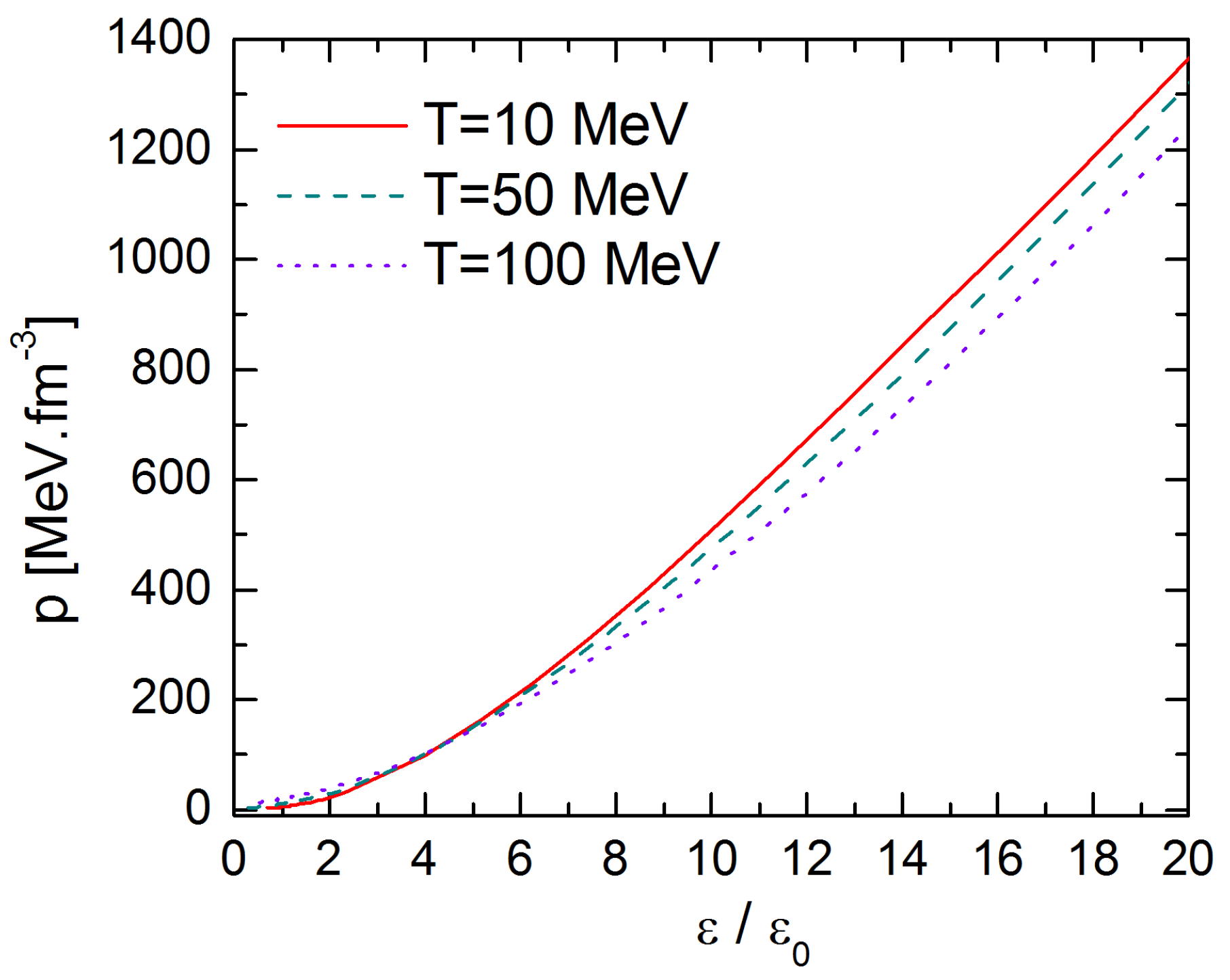
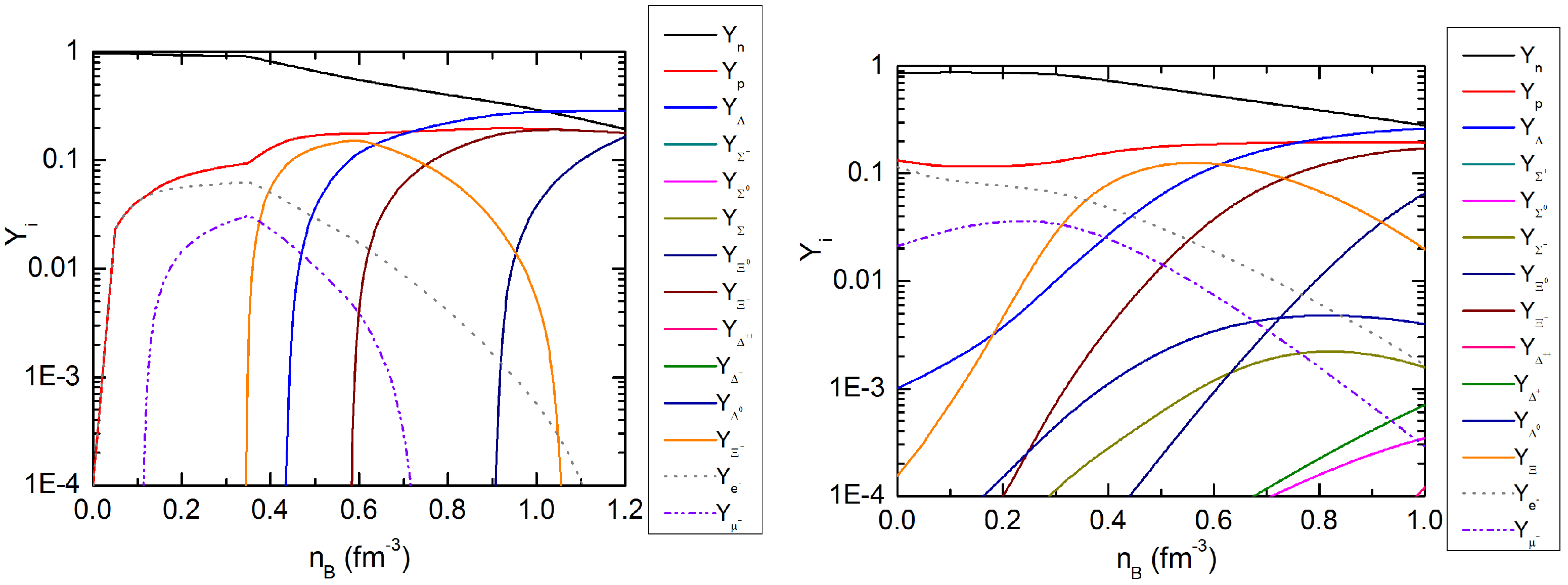
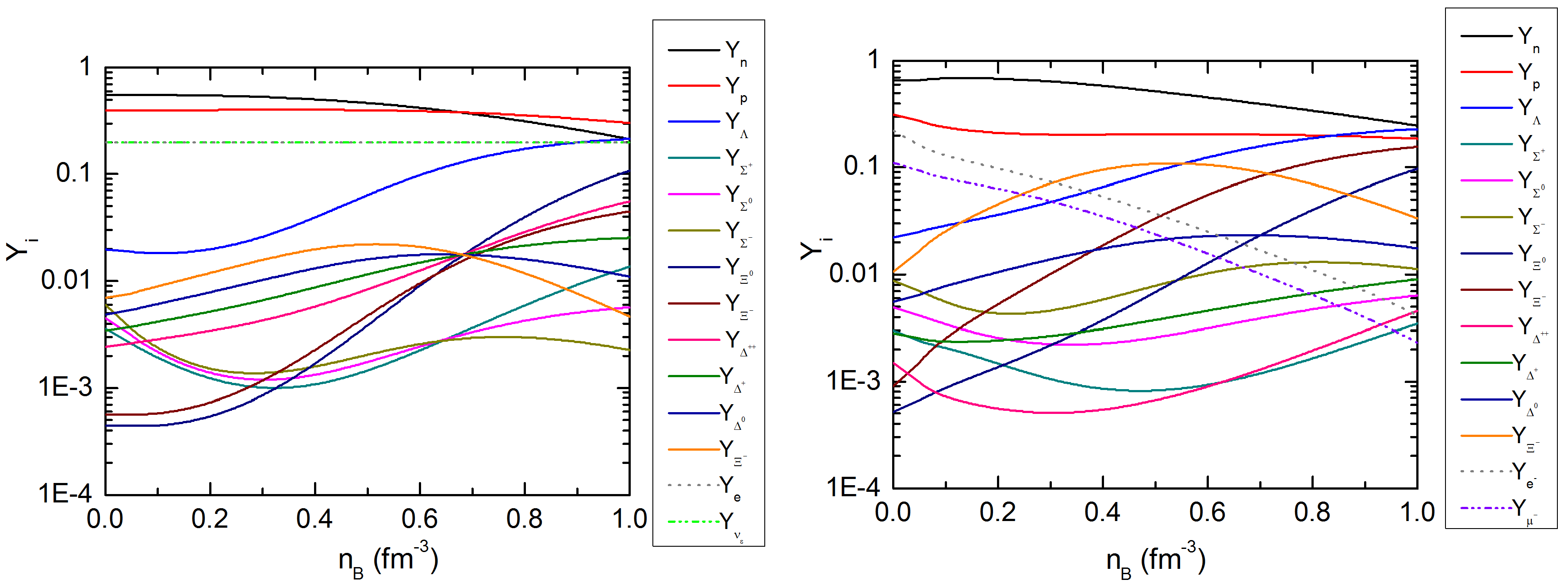
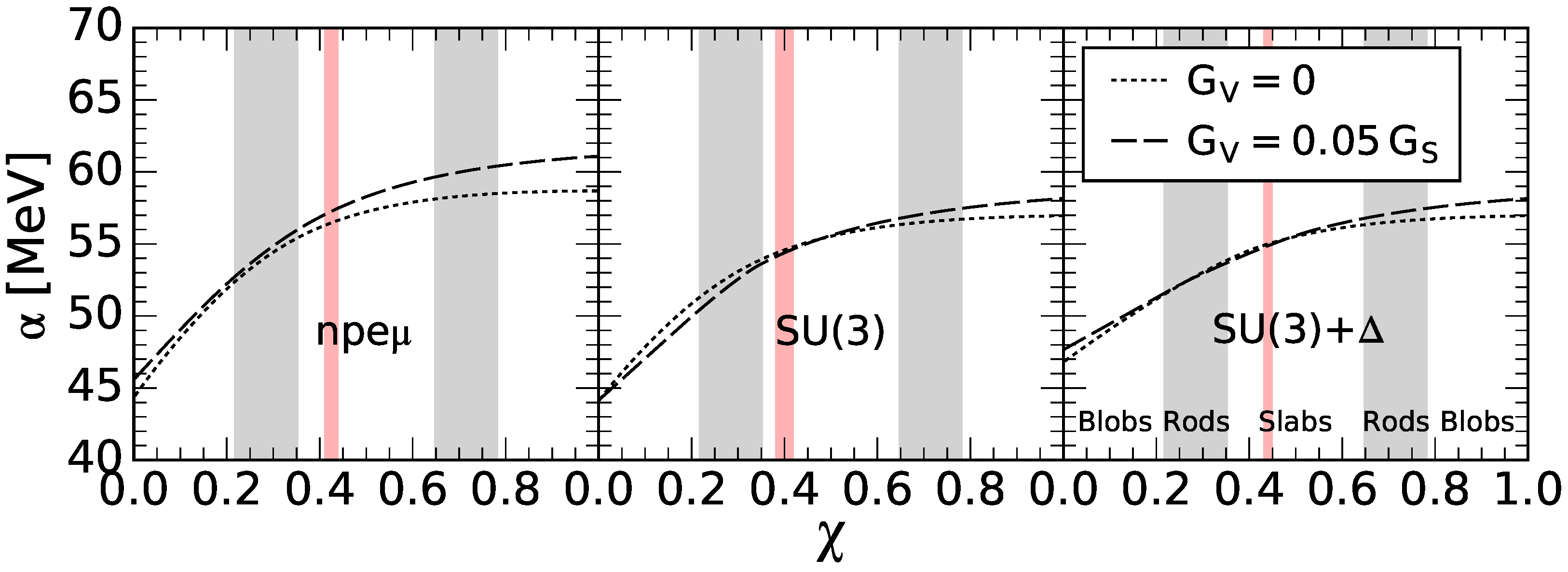
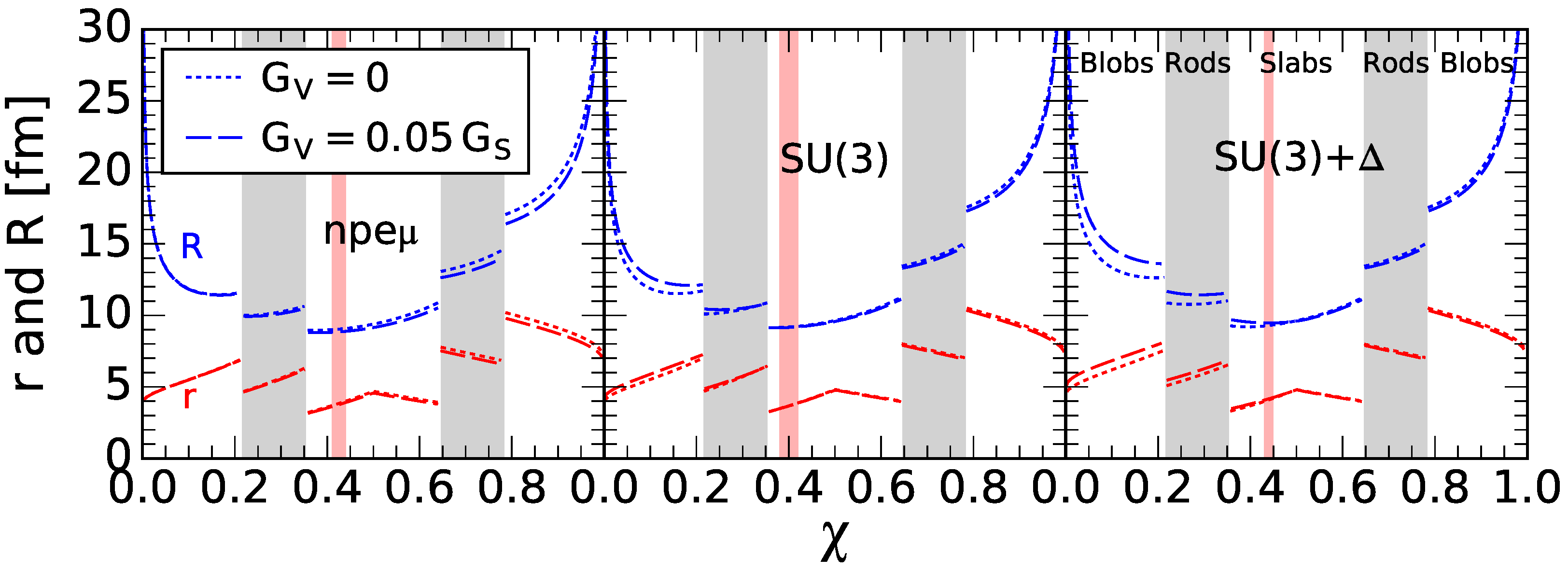
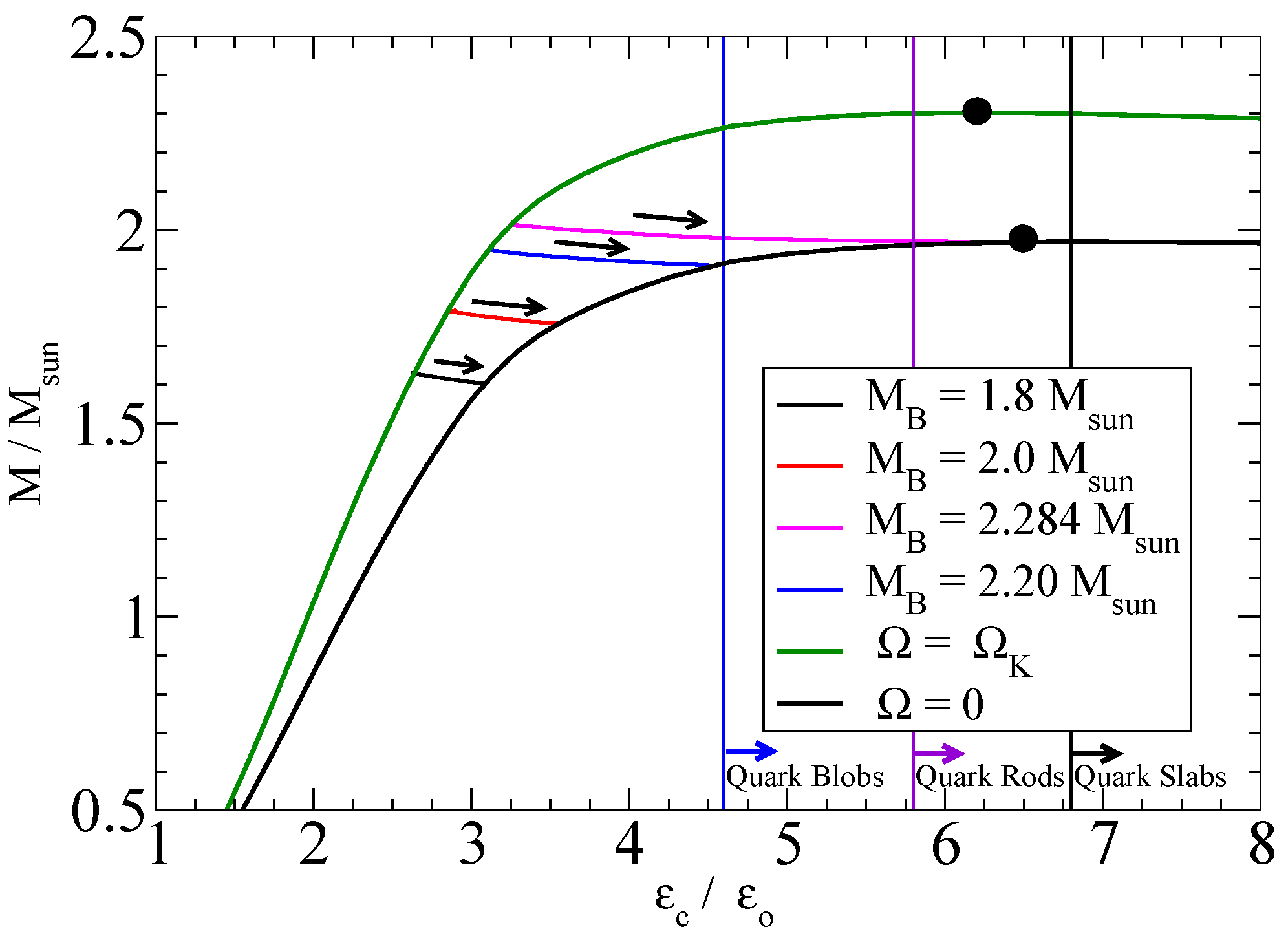
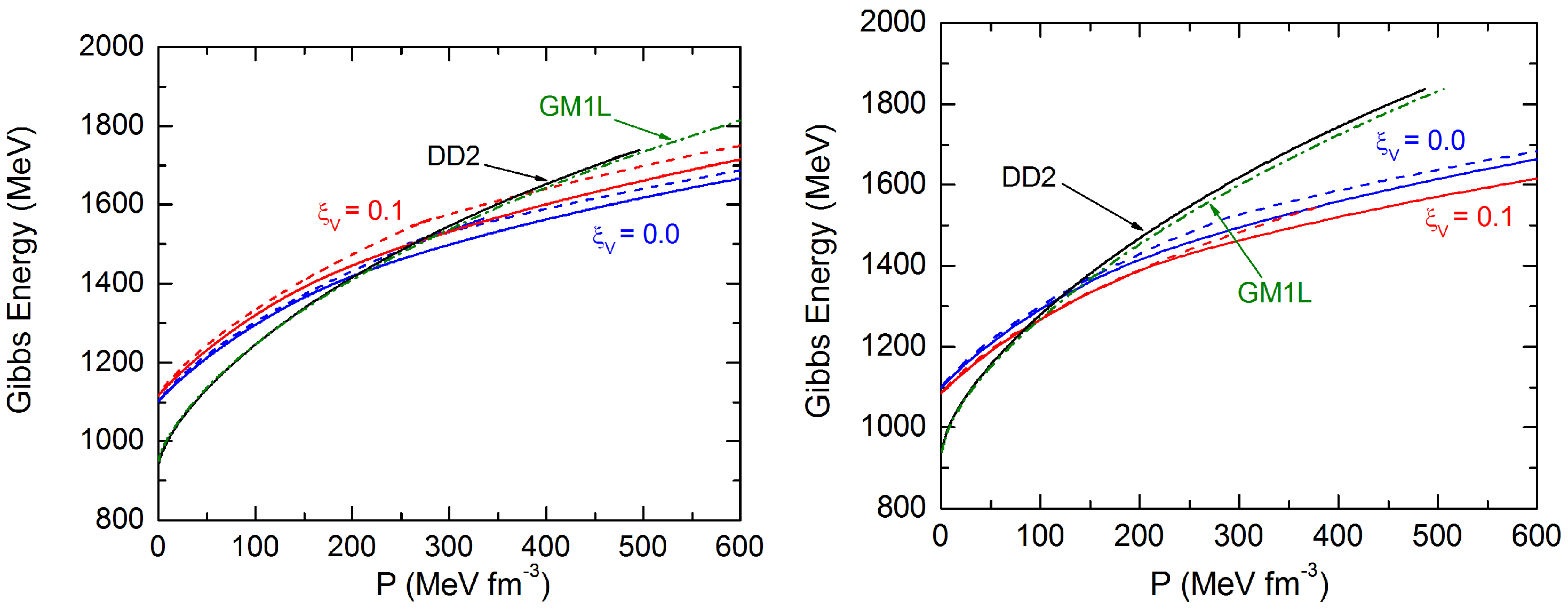
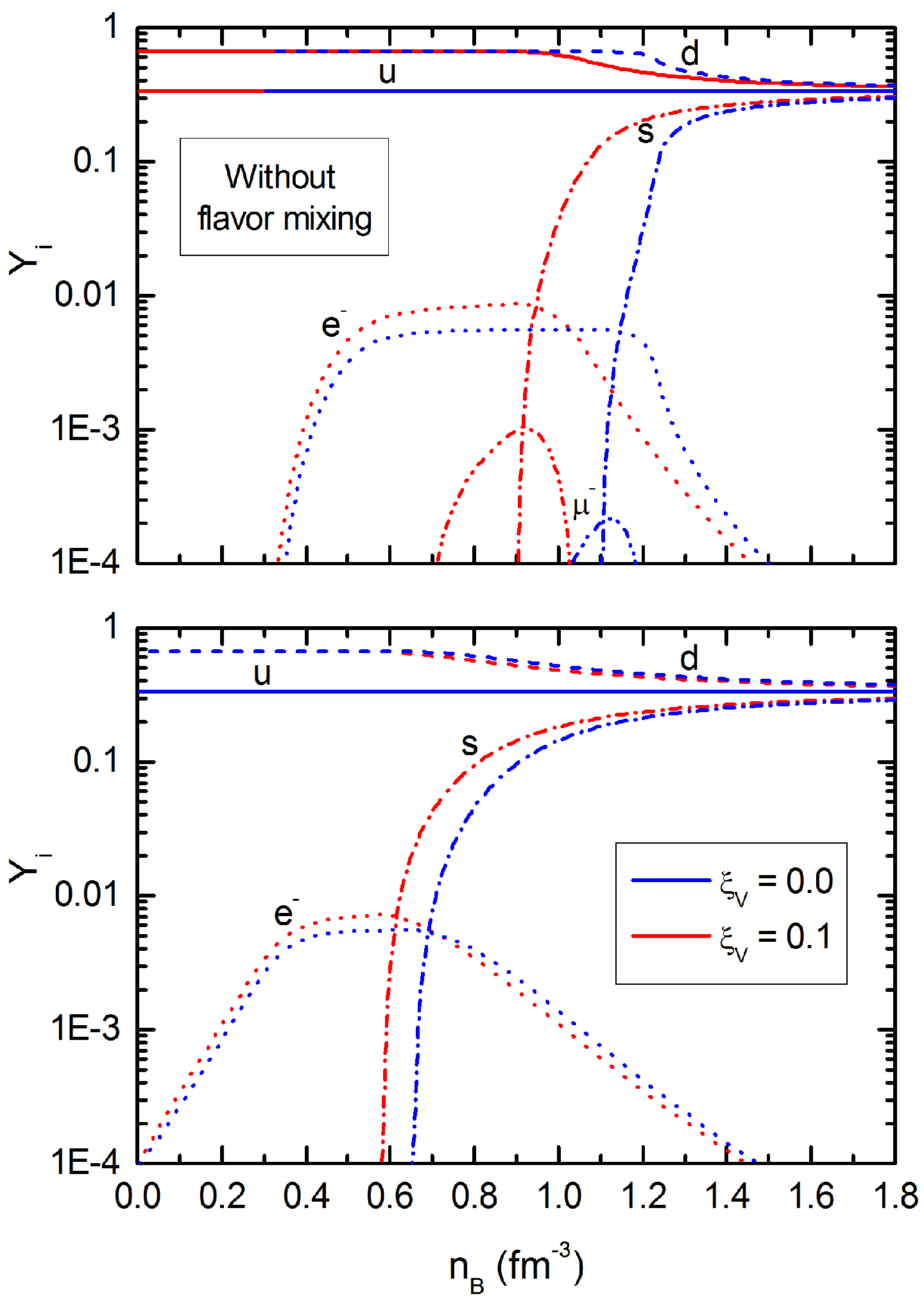
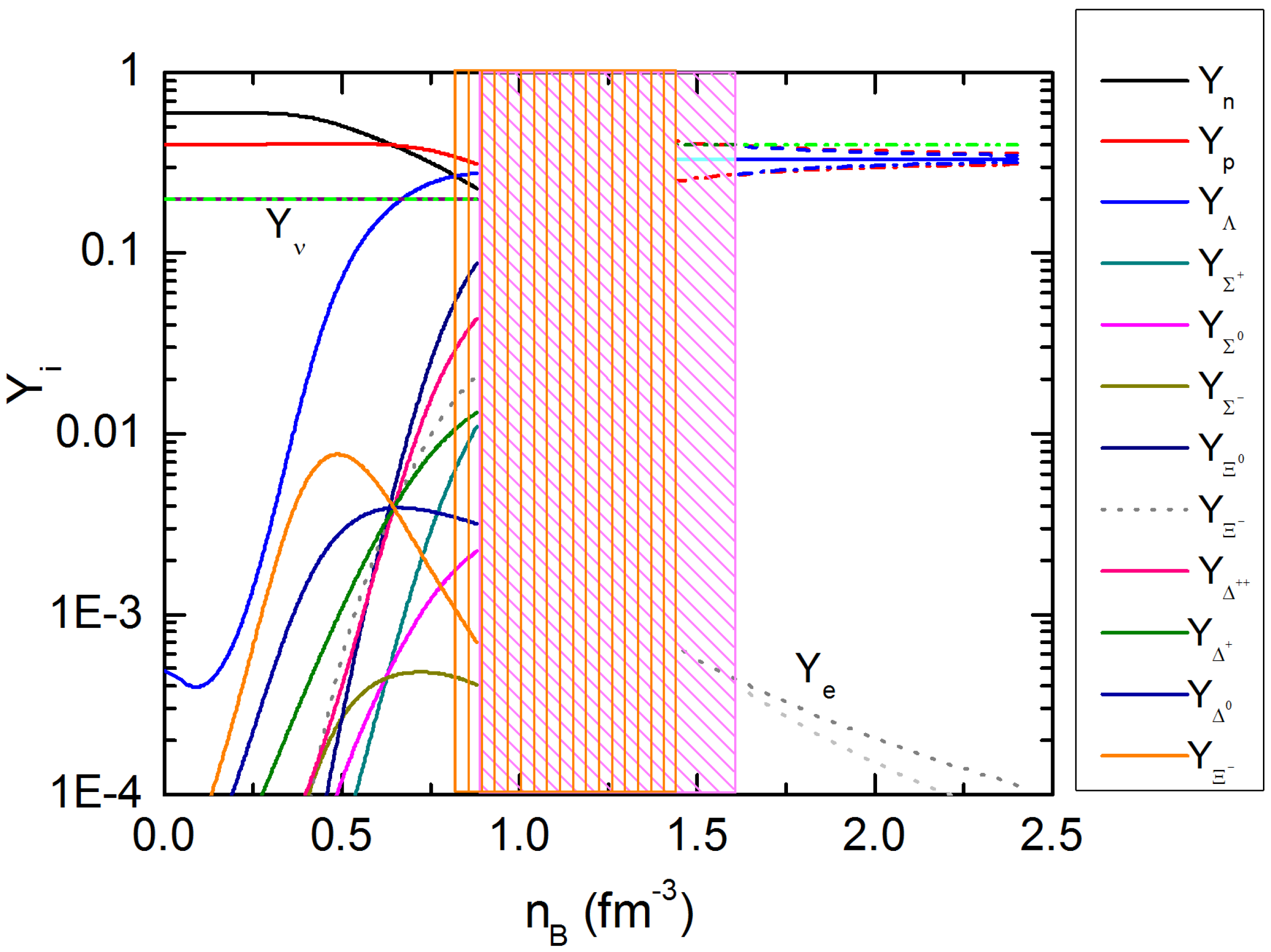
| Saturation Property | GM1L [1,14] | DD2 [21] | HV [22] |
|---|---|---|---|
| (fm) | 0.153 | 0.149 | 0.145 |
| (MeV) | −16.30 | −16.02 | −15.98 |
| (MeV) | 300.0 | 242.7 | 285 |
| / | 0.70 | 0.56 | 0.77 |
| J (MeV) | 32.5 | 32.8 | 36.8 |
| (MeV) | 55.0 | 55.3 | – |
© 2019 by the authors. Licensee MDPI, Basel, Switzerland. This article is an open access article distributed under the terms and conditions of the Creative Commons Attribution (CC BY) license (http://creativecommons.org/licenses/by/4.0/).
Share and Cite
Weber, F.; Farrell, D.; Spinella, W.M.; Malfatti, G.; Orsaria, M.G.; Contrera, G.A.; Maloney, I. Phases of Hadron-Quark Matter in (Proto) Neutron Stars. Universe 2019, 5, 169. https://doi.org/10.3390/universe5070169
Weber F, Farrell D, Spinella WM, Malfatti G, Orsaria MG, Contrera GA, Maloney I. Phases of Hadron-Quark Matter in (Proto) Neutron Stars. Universe. 2019; 5(7):169. https://doi.org/10.3390/universe5070169
Chicago/Turabian StyleWeber, Fridolin, Delaney Farrell, William M. Spinella, Germán Malfatti, Milva G. Orsaria, Gustavo A. Contrera, and Ian Maloney. 2019. "Phases of Hadron-Quark Matter in (Proto) Neutron Stars" Universe 5, no. 7: 169. https://doi.org/10.3390/universe5070169
APA StyleWeber, F., Farrell, D., Spinella, W. M., Malfatti, G., Orsaria, M. G., Contrera, G. A., & Maloney, I. (2019). Phases of Hadron-Quark Matter in (Proto) Neutron Stars. Universe, 5(7), 169. https://doi.org/10.3390/universe5070169






